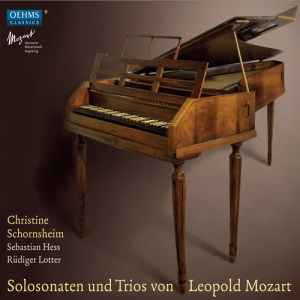 |
 |
|

Support
us financially by purchasing this disc from: |
|
|
|
|
|
|
Leopold MOZART
(1719 - 1787)
Sonatas for keyboard
Sonata in F (LMV XIII,1) [18:16]
Sonata in B flat (LMV XIII,2) [16:01]
Sonata in C (LMV XIII,3) [16:03]
Trios for keyboard, violin and cello
Trio in F (LMV XI,1) [09:47]
Trio in C (LMV XI,2) [07:00]
Trio in A (LMV XI,3) [13:03]
 Christine Schornsheim (fortepiano), Rüdiger Lotter (violin),
Sebastian Hess (cello)
Christine Schornsheim (fortepiano), Rüdiger Lotter (violin),
Sebastian Hess (cello)
rec. 31 October - 2 November 2011, music auditorium of the Zeughaus,
Augsburg (sonatas); 6 - 7 March 2012, Himmelfahrtskirche, Munich-Sendling
(trios), Germany. DDD
 OEHMS OC 860 [50:52 + 29:53]
OEHMS OC 860 [50:52 + 29:53]
|
|
|
The reputation of Leopold Mozart is rather ambiguous. Nobody
denies his decisive influence on the musical development of
his son Wolfgang Amadeus. However, he has also been accused
of exploiting his son's talent, being autocratic and manipulative,
and jealous of Wolfgang's success as a composer. As so often
it is not easy to create a historically accurate picture of
the man's character, but it seems that the negative assessments
are at least highly exaggerated. The suggestion that he was
a narrow-minded conservative are most definitely wrong as he
had a lively interest in the newest developments in natural
science and literature. Leopold also wrote one of the most important
treatises of the 18th century, Versuch einer gründlichen
Violinschule, which appeared in 1756, was then revised several
times, and found many reprintings, both in German and in various
translations. It gives much insight into the performance practice
of the time.
As a composer Leopold is hardly recognized. In the main it is
the symphonies and some orchestral works of a diverting character
that now and then are played and recorded. To the latter category
belong the divertimentos Die Bauernhochzeit and Die
musikalische Schlittenfahrt; the so-called Toy Symphony
- in fact also a divertimento - has long been attributed to
Haydn, but is now by and large considered a composition by Leopold.
It is a shame that it is merely the lighter side of his oeuvre
that is performed. There has always been speculation to what
extent Leopold had his hand in the early works of his son. It
is for sure that many of these include corrections in the hand
of his father.
The repertoire on this disc is interesting for two reasons.
Firstly, Leopold Mozart was one of the first who addressed much
of his music to amateurs. It doesn't require technical virtuosity,
and is of a mostly diverting nature. The three sonatas which
Christine Schornsheim plays were published between 1759 and
1763. They are all in three movements, beginning with an allegro,
which is followed by an andante. The closing movement of the
Sonata in F is called 'presto', which includes an episode
described as 'andante grazioso'. The Sonata in B flat
ends with an allegro, the Sonata in C with a pair of
minuets. Schornsheim doesn't attempt to make too much of them,
but rather plays them in a relaxed manner. The repeats of themes
and phrases are richly ornamented, as was expected from any
performer.
The second interesting aspect concerns the three trios. They
are a link between the sonata for violin and basso continuo
of the baroque era and the classical keyboard trio. The keyboard
and the violin are the main instruments; their relationship
is different. Usually the violin is in dialogue with the right
hand of the keyboard part. There are also episodes in which
the violin plays colla parte with it. On the other hand,
in some passages the violin plays a melody and the harpsichord
is reduced to the role of basso continuo. The cello merely supports
the bass part and could be omitted. These three trios were written
around 1750 and are preserved in an archive. The Trio in
F is in four movements; the second is called 'villanesca',
the third is a menuet. The Trio in C has only two movements,
an andantino and a menuet. The Sonata in A is in three
movements, again ending with a menuet. The character of these
trios has been perfectly captured by the three performers. This
is musical entertainment of fine quality and the performances
make for good listening.
Considering the date of composition the choice of the fortepiano
for the keyboard parts is highly questionable. Schornsheim plays
an original instrument dating from 1785 by Johann Andreas Stein,
a builder of keyboards who was greatly admired by Wolfgang Amadeus.
It is one of the few instruments of this builder which has survived.
It is used in the three keyboard sonatas which were recorded
in Augsburg where the fortepiano is kept. The booklet doesn't
make it clear whether this fortepiano was also used in the trios.
These were recorded in Munich, and I don't know whether this
precious instrument is transported to other localities. However,
in the time this repertoire was written the harpsichord was
still the dominating keyboard instrument. If we consider that
this music was written for amateurs in the first place, it is
very unlikely that Leopold had the fortepiano in mind. The liner-notes
admit as much. This is not the first disc where the author of
the booklet seems to have a different opinion from that of the
performers.
Even so, this should not hold anyone back from considering this
disc. It is one of the few devoted to Leopold's own compositions.
The performances do them full justice. I just hope that some
day we will also have the opportunity to listen to some of his
vocal music of which he has written quite a lot.
Johan van Veen
http://www.musica-dei-donum.org
https://twitter.com/johanvanveen
Support
us financially by purchasing this disc from: |
|
|
|
|
|
|
|

